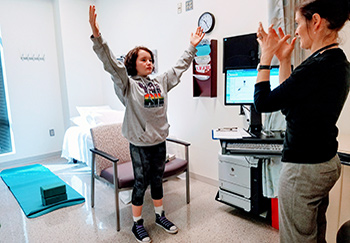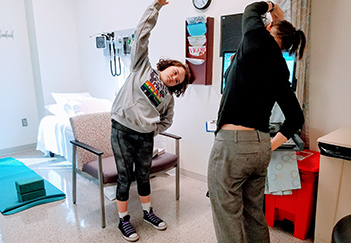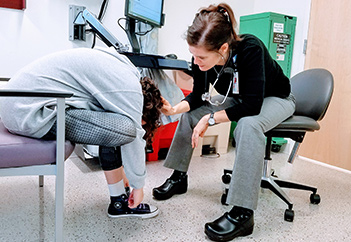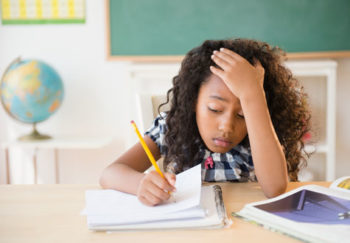
When my daughter was born, and she had trouble sleeping or became upset, I would hold her and nurse her. It always worked. When, as a baby, she cried, there were only a few options as to what she needed: food, sleep, a new diaper. Pretty straightforward stuff.
Now that my daughter is 12, things are way more complicated — proving something no one tells you about when you’re pregnant: The early days of diapers and pacifiers and all that, tiring as they are, are easy. It’s these pre-teen ages that really confound, challenge and tax your mental and emotional survival skills.
You can’t just stick a clean diaper on tween angst.
Sleepless Tween: What to Do?
So, a few months ago, I was feeling pretty helpless when Josephine started complaining about not being able to fall asleep. I know the connections between mood and school performance and rest. I not only needed to help her, I had to help her help herself. That’s the point of parenting, right? So, what to do?
Around that time, thankfully, I heard that the specialty clinic at Pantops had extended their medical yoga program for adults, which I’d written about before, to kids. I dragged Josephine to meet with Annie Way, MD. (“Come on, it will be fun!” Eye roll.)
Identifying the Source of Stress
Way, also a mother with a girl Josephine’s age, took every eye roll and tough pout of resistance — the signature stance of the teen — in stride. She sat down with my daughter, eye to eye, and asked her a thorough, in-depth list of questions. The attention and respect put my daughter at ease. I sat on the sidelines, having no idea how this would go.
First, Way took an inventory of Josephine’s sleeping habits — reading in bed, not sleeping, not dreaming when she sleeps. Josephine talked about how even a small crack of light keeps her up. They discussed blackout curtains.
Then Way asked about my daughter’s support system. “Who do you talk to when you feel crummy?”
“My friends and sometimes my mom,” Josephine replied. (Score for me!)
I wasn’t surprised that she said she worried about her grades. But the fact that she worries about being on time for school so much, and the emphasis she gave to how much her little brother annoys her, surprised me.
Way asked about her diet: “Where are the vegetables or fruit?”
My daughter’s response: “What do you mean?” (Sigh. Take off my points.)
Way asked about life at home. “Is family life difficult – stressful? Relaxing?”
Josephine responded that it was not relaxing and that her parents are “annoying.”
I must have made a noise of horror, because she promptly turned to me and said, “You annoy me, but I know you love me.” (Well.)
“What makes you feel good?” Way asked.
“Reading, writing, finishing my homework, petting my dogs, swimming,” said Josephine.
“Your dogs really ground you?”
“Yes.”
At the end of the assessment, Way announced that Josephine had scored as having “moderate anxiety according to scale.” She added, brightly, “It’s good to deal with it now, and you can do that!”

How to Help Anxiety in Children
She then advised us on things we could do that would help with anxiety and sleeplessness, like:
- Making sure Josephine gets vegetables and fruit: “You are what you eat!”
- Including more leafy green vegetables, which have B vitamins and folate that help with anxiety
- Getting more exercise — Way and Josephine determined that taking the dogs for an afternoon walk every day would be the perfect way to get out energy while doing something enjoyable
- Finding practical ways to make the room dark – an eye mask, dark curtains
- Getting out of bed after 20 minutes of not sleeping – “Get up, do something that will tire you, then go back and try again”
- Not reading in bed
Way said to my sleepless tween: “Sleep takes priority over school in my house. You’re not going to learn anything if you’re not rested.”
Teaching My Child to Meditate
Way talked a lot with Josephine about her thoughts. Her solutions weren’t so much about me doing anything, as the parent, but empowering Josephine to respond to the world in a healthy way.
“You can’t control what happens to you, but you can control how you handle things,” she said. “You can change your thought patterns.”
And she led her through a brief meditation to help her do that.
“If it’s a rushed morning, and you’re worrying about being late, you’re going to stop the thoughts. Realize nothing is going to happen if you’re late. Take three deep breaths. Show me how you take deep breaths. Shut your eyes.” Way had Josephine think of a place she loves and mentally go there.
“We need to shift to positive thinking,” Way said. “Your brother annoys the heck out of you, but if he wasn’t there, it would be horrible, right?” My daughter couldn’t disagree.

The Yoga Prescription
At the first of three sessions, the yoga all took place in a chair.
“Start with breathing. Sit comfortably in a chair. Put your feet down. Take breaths. Nice deep breaths. 3 times. Hold and sustain.”
Way then directed Josephine through a series of moves and stretches that combined yoga postures and meditation.
Way instructed, “Do this twice a day every day if you can, in the morning and right before you go to bed for 10 minutes. This is your yoga prescription. There will days you miss, and that’s OK.”
She explained to Josephine that “studies show this practice can reduce anxiety. You’ll feel better.” But she was also realistic. “Your anxiety will always be there. That’s the way you’re wired. But you can change how you react.”
Way explained to me that with medical yoga, “The focus is on breath and concentration or meditation — very different than what most people think of as yoga. But if the only message you take home is to breathe and find peace throughout the day, that’s enough.”
“I think you did great today, by the way,” Way told Josephine, as we left.
And my daughter smiled.
Yoga Poses at Home
Josephine took the instruction sheets and did as Way had prescribed. If we walked into her room to say goodnight, we’d often find her in the dark, in a yoga pose, the room filling up with a slow, strong breath. Every day, she walked the dogs and added an apple to her lunch bag. She also started wearing a sleeping mask and – the hardest thing – stopped reading in bed.
Did it work? For the most part, yes. The biggest point for Josephine was probably that she had taken control of her own mood and sleep. It also gave me, as a parent, tools to use when Josephine panicked. We could do deep breaths together, and when she acted out, sending her to her room to do yoga wasn’t about punishment so much as giving her time and space to regroup.
At her two subsequent appointments, Josephine learned some standing poses to add to her routine.
Did the Medical Yoga Work?
When I asked my daughter recently, about six months after that initial appointment, if she felt the yoga had helped and that she would recommend it to other kids, I got this robust answer: “Yes.”
After pushing and pulling for more details — oddly, the child can chatter for hours about the dystopian novels she’s reading, or provide in-depth analysis on what color her hair might be turning, but when I inquire about anything, she’s restricted to one syllable — she finally articulated that, “Yoga really helps me calm down when I need to.” And she admitted that, since doing yoga, “I have slept better, and I’ve been less anxious.”
Having elicited whole sentences from her, I made the mistake of asking this formerly sleepless tween for her opinion on why yoga helped.
“Because it just does,” she said.
Try Medical Yoga for You or Your Teen
High blood pressure, stress, insomnia: Medical yoga can help anyone at any age. Find out if yoga could work for you.
Medical Yoga & the Teen Brain
Of course, in some ways, Josephine’s right. Breathing and stretching and changing thought patterns can reroute the circuitry in the brain, and I know that that the adolescent brain is extremely malleable. Like Way said, Josephine has a good chance at managing her stress and anxiety now and for the rest of her lifetime.
Parenting a preteen may not be as easy as caring for a baby, but then, having kids isn’t about easy. Watching my daughter learn to deal with the stresses and worries of life has helped me realize that my job is never about fixing the hard things but about caring for her – and myself – when hard things happen.
And I’m grateful that we have a doctor, a clinic and a health system, that understands that and is here to help.


Great article. Amy..just found while googling this topic.
Amanda! Thank you so much for the compliment! And for reading. Good to hear from you! Best, Amy